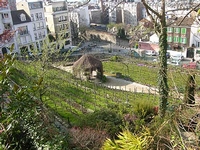Certain cities have a special attraction, a captivating appeal that sets them apart, offering an open invitation to return. Paris is like that. I’m not sure how many times I’ve visited Paris, but I do know that after dropping my bags in my hotel room, the first thing I do is go for a walk. No matter how many times I’ve been to Paris, there is always something new to see.
On my last stay in Paris, I discovered the Orangerie Museum, in the Tulleries Gardens, an amazing collection of impressionist art, including the exquisite water lily series by Monet that I had never seen. Then, there’s the Paris attraction that I have missed time and again (since 1955) for one reason or another, the vineyard on a hill (the Butte) in Montmartre. The compact Le Clos Montmartre vineyard is nestled at the busy intersection of rue des Saules and rue Saint Vincent, ringed by apartment houses, private residences, cafes and shops and near the majestic Sacré Coeur church, that sparkling white marble beacon of the 18th arrondissement.
majestic Sacré Coeur church, that sparkling white marble beacon of the 18th arrondissement.
Le Clos Montmartre may be the only vineyard within the city limits of a large metropolis, but it wasn’t always that way. In the 16th century, residents of Montmartre, which at that time was outside the city of Paris, were mainly wine growers and vineyards covered many of the hills of Montmartre. The wines produced from the Montmartre vineyard then known as Mont Mercure, were held in high regard, particularly La Gouette d’Or that was known then as the “king of wines.” Unfortunately, many of the wines made from the Montmartre vineyards had diuretic qualities, so by the 17th century the vineyards had mostly vanished.
In 1933, at the urging of the mayor of Montmartre and the Vieux Montmartre Society, the Paris City council planted 2,000 vines. The following year, even though the vines were only one-year old, the mayor created the fete du vin, with wines made from 30 tons of grapes brought in from the provences. That first fete du vin has become the Fete des Vendange de Montmartre, a five-day festival of wine, food, parades, fireworks and music, all centered around Le Clos de Montmartre.
By the 1940s, the Montmartre vines were producing mature grapes fit for wine that was pressed and fermented in the cellars of the mayor’s offices. In recent years, members of the Paris Parks and Recreation Department pick the grapes and the wine is fermented in a nearby facility. Le Clos Montmartre wines are offered for sale at the fête du vin, with proceeds going to charities in Montmartre. Today there are 27 different varieties planted in Le Clos Montmarte, with the majority planted to Gamay Noir, Pinot Noir and Landay, an obscure acidic grape grown on the north side of the Butte that is used to make Le Clos Montmarte Rosé.
Alas, my visit was in July, a full four months before harvest, so most of the small quantity of Les Clos Montmarte wine produced from the previous vintage had already been sold, mostly at the previous Fete des Vendanges de Montmartre. I checked a few cafes, but never got to taste the wine of Paris, although café employees I spoke with assured me that I was not missing anything.
When you are used to seeing vineyards in vast open spaces, it comes as a surprise, an odd but pleasing surprise, to come upon Le Clos Montmartre. Standing at the intersection and looking at the patch of dark green vines surrounding by tall buildings and cars zooming up and down the adjacent streets, there is a satisfying sense of knowing that an urban vineyard survives and continues to give pleasure to the senses of sight and taste.
If you are planning to be in Paris in October, Fete des Vendanges de Montmartre will be held October 5-9, 2011. There is plenty to do with cooking demonstrations and purveyors from all over France selling wine, bread, olive oils and more in stalls set up around the Sacre Coeur. Other events including music, parades and demonstrations are scheduled through the festival.
6
